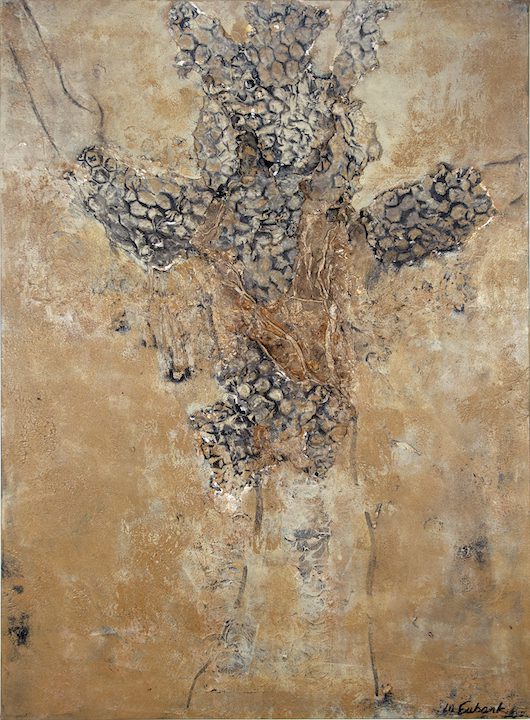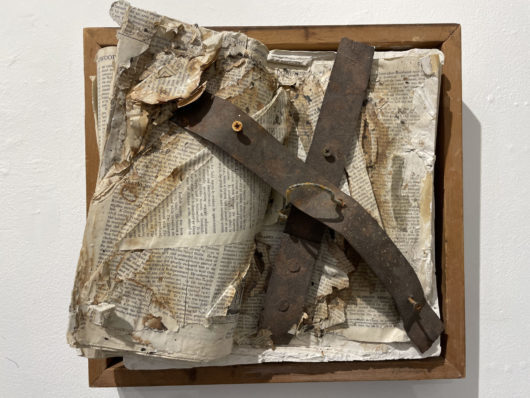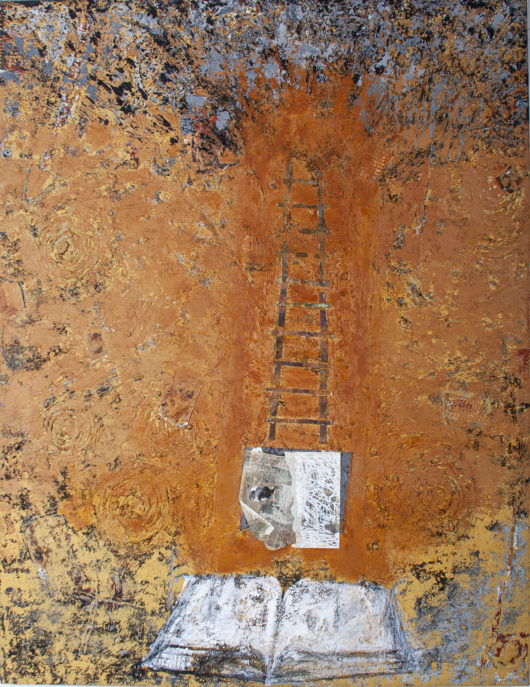Location: US Bay Area/Pt Reyes Stn

BEEKEEPER, Mary Eubank.
I. INTRODUCTION
MARY MOUNTCASTLE EUBANK is an artist living in Inverness, California a village in Marin County. She is a founding member of Gallery Route One and served as Director, then Co-Director of the organization’s Project Space Program, before retiring in 2020. Zea Morvitz, also an artist and founding member of Gallery Route One, served as Co-Director with Mary and is currently Director of Gallery Route One’s Project Space Program for Visiting Artists. Project Space encourages proposals for exhibitions about climate change and the accelerating threat of over-development to our planet. This brief article, told from Zea’s point of view, chronicles the founding of Gallery Route One, the initiation of With the Earth: Arts and the Environment, our Visiting Artist Program with a focus on the environment. The second section discusses Eubank’s work as an artist.

BOOK WITH X, Mary Eubank.
II. FOUNDING GALLERY ROUTE ONE
I MET MARY IN THE EARLY 1980s, as Gallery Route One was being imagined by 25 West Marin artists. Mary was a central figure in founding GRO, as we came to call it, along with painter Toni Littlejohn and sculptor Ted Odza. I was a newcomer to West Marin, but with my husband-to-be, Tim Graveson, I joined other local artists to talk about how we might create an art gallery in Point Reyes Station. Mary had worked for the Lester Gallery in downtown Inverness, so she had some experience to offer in contrast to most of us who were eager to be part of a gallery but ignorant of the business and legal requirements.
Mary, Ted and Toni were our guides as we talked and argued our way towards a coherent art organization. Our 25 artist members made collective decisions about the operation of the gallery and the members agreed to adhere to the parameters decided on by the group. We designed a logo for ourselves and came up with standards for exhibitions and publicity.
During the gallery’s first year the artist members exhibited their own work, but in the following years the group began to share the space, gradually inviting nonmember artists into our exhibition schedule. When an adjacent room in the building became available, the artist members set aside this space primarily for guest artists. Mary took the lead in inviting artists from San Francisco and the East Bay to exhibit in the new space. She then realized that if GRO could become a nonprofit organization, it would be eligible for funding to underwrite an ongoing program of visiting artists, as well as other community service programs. In 1986, after a year of patient wrangling with the IRS, Mary secured Gallery Route One’s nonprofit status.
In 1989 the Exxon oil tanker ran aground off the coast of Alaska. This event caused extensive environmental damage, killing plants, birds, and sea creatures. This environmental disaster was keenly felt in the Bay Area and communities along the California Coast. We felt an urgent need to respond. The question for us was Can art be a force for societal change? The organization responded with a series of events under the general title: What Have We Got to Lose? These events included a juried exhibition: Artists and the Environmental Crisis, an invitational exhibition, For A Fragile Planet in our gallery; an environmental fair at The Dance Palace Community Center, with performance, music and informational booths. There were additional satellite events, outdoor art installations, as well as a Symposium titled Beyond Artifice. We published What Have We Got to Lose? a booklet with essays by artist activists and environmentalists, edited by Rebecca Solnit, who also contributed an essay.
III. WITH THE EARTH

TREE WITH BOOK, Mary Eubank.
AT THE END OF JULY, 1990 Mary proposed that over the next 5 years the visiting artists exhibitions in GRO’s Project Space be devoted to the theme of the environment. The members agreed and Gallery Route One became one of the first Bay Area art venues consistently offering exhibition space to artists who recognized the environmental crisis looming before us.
Those five years stretched to ten during which 4 to 5 Project Space exhibitions each year were devoted to the series: With the Earth: Arts and the Environment. During that time GRO presented work by many W.E.A.D. artists individually and in group shows.
What Have We Got to Lose introduced us to many artists working in the environmental arena and was very exciting. Because it reflected my own interests as an artist and someone alive on this wonderful planet, I began to think about continuing this environmental programming focus. “With the Earth” has given us a central programming theme that provides opportunities to network and support environmental artists while offering a larger service to the world. I created the name With the Earth because I thought of us as working interdependently and in concert with the earth.– Mary Eubank, from an Interview with Danny Hobson, 2005
GRO’s continuing engagement with the environment also inspired an Artists In the Schools program (AIS). In the early 1990’s Toni Littlejohn had begun working with students at West Marin School as a volunteer art teacher. The teachers and principal recognized the value of the fledgling program and in 1993 formalized a relationship with our Artists in the Schools program with Toni as its Director. The AIS program is ongoing and continues to engage students in projects pairing art with the science curriculum that encourages stewardship of the Point Reyes environment.
One of the early AIS projects, led by artist Dan McCormick, was the creation of woven structures to slow the flow of water in Papermill Creek to encourage salmon spawning. Later students assisted in returning cow pasture to wetlands in the creation of the Giacomini Wetland in Point Reyes Station. In 2013 Jane Ingram Allen, a resident at the Lucid Art Foundation in Inverness, helped AIS students build nests of bio-degradable, seeded paper. Students and community members built giant nest structures outdoors at Point Reyes Station. This year’s AIS project has been focused on Seeds, Cycles of Life, taught by a team of artists including one GRO Board Member, an Artist Member and both GRO Fellows.
By 1995 Mary and I had become good friends through collaborative art projects. We live less than half a mile from each other and Mary would stop by to talk over ideas she had for With the Earth exhibitions. Eventually I found myself without a job and at the same time Mary told me she had begun to look for someone to share her increasingly complex job as Project Space Director. One day we were talking about this, and I asked, “Have you talked to X (an environmentally focused artist) about taking the job, yet?”
“No”
“Well I was thinking I might “
“You’re hired.”
For the next 10 years Mary and I served as Project Space Co-Directors and continued to invite exhibitions of environmentally focused art. For quite a few years we attended the annual Bioneers Conference in San Rafael, to hear the latest on environmental science and we head-hunted for artists to exhibit in the With the Earth series.
Through their Project Space Program, GRO created several multi-venue environmental projects. On the Edge: Intersections and Interactions, was a two month interdisciplinary exhibition project with Judith Selby Lang and Richard Lang that explored the regional coast and issues affecting it. On the Edge included shows at Gallery Route One and at the National Seashore visitor centers, There was a walking tour led by project artist Dan McCormick of our creek restoration project, a collaboration with West Marin School students and the Park Service. A panel discussion on the political issues was held at the Dance Palace Community Center. California Current in 2005, and Turning the Tables, a few years later, were multi-venue events with participation by other art organizations and exhibitions in venues in San Francisco and the Greater Bay Area.
We have since expanded our Project Space Program to include an annual exhibition on immigration, and more recently social justice as another exhibition theme. It has become increasingly obvious that these issues are interconnected. The Project Space Program for Visiting Artists continues at GRO although Mary retired as Co-Director in 2020.
IV. LET NATURE BE YOUR GUIDE

TREE, LADDER, BOOK, Mary Eubank.
MARY LIVES IN A HAND-BUILT house at the edge of the forest of pine, oak, bay and madrone trees covering the Inverness Ridge. Aside from private inholdings, much of this land belongs to the National Seashore. Although is a beautiful area it has become increasingly dangerous living at this interface between human habitation and uninhabited forest. A fire burned across the ridge in 1995, and an area of the National Seashore burned in summer 2020, ignited by a lightning storm that passed over the Point Reyes Peninsula.
Mary’s paintings and assemblages owe much of their meditative atmosphere to the forest and the solitude you experience living among the trees. The mineral quality of the Southwest landscape is also present. Her artwork of the past few years, acrylic and mixed media paintings on canvas and assemblages of found materials, incorporates pages from old books, cloth from worn clothing, minerals including raw ocher, with found fragments from our industrial wasteland mixed in.

BOOK WITH HAND, Mary Eubank.
Some of Mary’s paintings contain a performative aspect, as in the gloved hand that appears in the painting, Book with Hand; another, Book, Ladder, Tree suggests the ladder by which ancient gods might descend to speak with humans. Other paintings present an ambiguous world where human presence is suggested by a book, often placed at the base of a “primeval” or mythic tree. Mary has said that the trees appearing so often in her paintings signify the forest primeval (quoting Longfellow from her grade school days) they are trees of an older, greener world.
Another element in Mary’s work is layering. This can refer to the physical process of making. As Mary describes it: layering is the process of painting on, scraping off, painting on again, etc. In addition, layering also describes the combining of materials, cloth over paint, paint over sand, over crushed pigment – techniques that give her paintings a solidity akin to naturally occurring rock surfaces, a quality of embeddedness and weathering that points to the dimension of time
V. ALCHEMY

BLUE ROOTS, Mary Eubank.
BEFORE SCIENCE, ALCHEMY was the discipline that combined knowledge, including natural history with the technology of the day. Due to alchemy’s origins in the late Classical world, alchemists had a meditative, spiritual understanding of the materials of this world. The writings and the artwork of Early Modern alchemists has left an indelible mark on Mary’s art practice and artwork.
“The study of Alchemy has for many years informed my work, particularly in the processes used to make the work. The evidence of burning, exposure to water and air and the inclusion of earth and ash are part of the art making process. The process of layering paint, organic materials and objects and the rough surfaces that result bring the notion of time and endurance to mind. The book images that are often included are battered cultural artifacts that reflect a human presence that may or may not be relevant to the world of nature.
The colors, textures and gestures come directly from observation of nature, not in imitation of any particular landscape but rather to point to a relationship that we have with the natural world. The work results from a retreat into the wild places, both in nature and the human psyche, the retreat being an essential part of the artist’s process.
I have always been intrigued with the relationships between spirit and matter and between magical practices and natural processes and have been combining acrylic paint, found objects and materials, and mixed media to make paintings and sculpture that reflect my love for the natural world.”
PHOTO CREDITS:
Mary Mountcastle Eubank, Folio for the exhibition, Layered in Time, 2021.
WEAD MAGAZINE ISSUE No. 12, TAKING ACTION
Published October 2021
